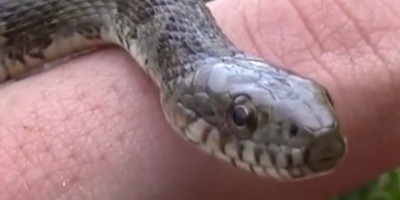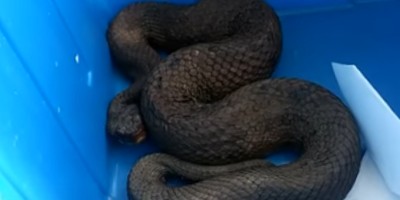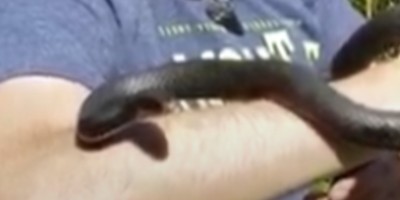
Welcome to charlottesvillesnakes.com! I am David, a snake enthusiast living in Charlottesville, VA. Many people don't know that Charlottesville is in fact full of snakes! You just need to know where to find them - they can often be shy and elusive. Some Virginia snake species are more common outside of the city limits, in different parts of Albemarle County VA, but many types of snakes are indeed common in the more urban parts of Charlottesville. This guide is meant to help educate you about the beautiful snakes of Charlottesville, and to help you identify the most common snakes of Charlottesville, as well as the venomous snakes of Charlottesville that you should learn to recognize and avoid. If you want more detail, click here for my complete list of ALL snake species in Charlottesville. Remember the following:
- Most snakes of Charlottesville are harmless and don't want to encounter you
- Venomous snakes exist but are uncommon in Charlottesville, Virginia
- Snakes eat rats and mice and are a valuable part of the Virginia ecosystem
- Never kill a snake - if you leave a snake alone, it will leave you alone.
Common Snake Species in Charlottesville
 Northern water snake:
The northern water snake is one of the commonest snakes found in Virginia that is mistaken for the venomous water moccasin. They have different colors, including gray, brown, and tan. The snakes are non-venomous. As the name suggests, they are closely associated with water bodies. You could encounter them while they bask on rocks. They are also commonly found close to or around slow-moving or still water bodies.
Northern water snake:
The northern water snake is one of the commonest snakes found in Virginia that is mistaken for the venomous water moccasin. They have different colors, including gray, brown, and tan. The snakes are non-venomous. As the name suggests, they are closely associated with water bodies. You could encounter them while they bask on rocks. They are also commonly found close to or around slow-moving or still water bodies. Eastern garter snake:
The eastern garter snake is otherwise known as the small snake that was designated the state snake in 2016. They are greenish to brownish in color. You could identify these snakes by their color as well as the numerous white spots that adorn their bodies. Adult eastern garter snakes can attain lengths ranging from 18 inches to 26 inches. The snakes feed on small animals like spiders, earthworms, frogs, small fish, and toads. Although it is a non-venomous snake, the eastern garter snake will bite if it is threatened. A unique behavioral pattern of the snakes is to release a foul-smelling musk when they are handled.
Eastern garter snake:
The eastern garter snake is otherwise known as the small snake that was designated the state snake in 2016. They are greenish to brownish in color. You could identify these snakes by their color as well as the numerous white spots that adorn their bodies. Adult eastern garter snakes can attain lengths ranging from 18 inches to 26 inches. The snakes feed on small animals like spiders, earthworms, frogs, small fish, and toads. Although it is a non-venomous snake, the eastern garter snake will bite if it is threatened. A unique behavioral pattern of the snakes is to release a foul-smelling musk when they are handled.
 Northern cottonmouth:
The northern cottonmouth, otherwise known as the water moccasin, has a distinctive physical feature. When it opens its mouth, a white lining is very visible. These snakes, which are found around aquatic environments, are also known for the way they do not back down from a threat. Instead of retreating, they stand their ground and form a tight coil. Northern cottonmouths are venomous snakes that are mostly associated with freshwater bodies. They are found along streams and rivers.
Northern cottonmouth:
The northern cottonmouth, otherwise known as the water moccasin, has a distinctive physical feature. When it opens its mouth, a white lining is very visible. These snakes, which are found around aquatic environments, are also known for the way they do not back down from a threat. Instead of retreating, they stand their ground and form a tight coil. Northern cottonmouths are venomous snakes that are mostly associated with freshwater bodies. They are found along streams and rivers.
 Black racer snake:
The black racer snake is a long, slender black snake with an average length of 20 to 60 inches. They can adapt to a wide range of habitats but are commonly found along the edges of forests and fields. They are mostly active during the day when they hunt for the different small animals that make up their diet. Even though they do not produce venoms, they strike and bite, especially when they are cornered. The black racer snake could be found hiding under rocks and debris during the day. They are fast snakes and apply this impressive speed to escape threats. When they rest, they take a kinked position. In this position, they can be mistaken for a stick or tree branch.
Black racer snake:
The black racer snake is a long, slender black snake with an average length of 20 to 60 inches. They can adapt to a wide range of habitats but are commonly found along the edges of forests and fields. They are mostly active during the day when they hunt for the different small animals that make up their diet. Even though they do not produce venoms, they strike and bite, especially when they are cornered. The black racer snake could be found hiding under rocks and debris during the day. They are fast snakes and apply this impressive speed to escape threats. When they rest, they take a kinked position. In this position, they can be mistaken for a stick or tree branch. Venomous Snake Species in Charlottesville
 Eastern copperhead:
This is a common venomous snake in Virginia. Copperheads can be identified by their copper-colored heads, although other harmless snakes could still be mistaken for them. The snakes also have a distinctive hourglass pattern on their backs. The eastern copperhead is found in almost every part of Virginia. The snake has a pinkish or copper-colored body. The average length of the eastern copperhead is between three and four feet. Although they typically like to stay away from any kind of intrusion, they will resort to biting and injecting their venom when they are threatened. The bite of the eastern copperhead can lead to serious consequences.
Eastern copperhead:
This is a common venomous snake in Virginia. Copperheads can be identified by their copper-colored heads, although other harmless snakes could still be mistaken for them. The snakes also have a distinctive hourglass pattern on their backs. The eastern copperhead is found in almost every part of Virginia. The snake has a pinkish or copper-colored body. The average length of the eastern copperhead is between three and four feet. Although they typically like to stay away from any kind of intrusion, they will resort to biting and injecting their venom when they are threatened. The bite of the eastern copperhead can lead to serious consequences.  Timber rattlesnake:
The length of timber rattlesnakes found in Virginia ranges from three feet to five feet. The body of these snakes is colored gray, brown, yellow, and tan. The snakes have dark bands with different patterns that run across their bodies. Timber rattlesnakes are known for their camouflaging abilities which they apply to easily wait for their prey. They are mostly found in hilly areas and general high elevations. They rattle when threatened to warn the intruder or predator of their intent to strike. They feed on small animals and birds. Although the bites of timber rattlesnakes can lead to serious consequences, bites are not common, probably because they stick to high elevations and are generally shy. 2.
Timber rattlesnake:
The length of timber rattlesnakes found in Virginia ranges from three feet to five feet. The body of these snakes is colored gray, brown, yellow, and tan. The snakes have dark bands with different patterns that run across their bodies. Timber rattlesnakes are known for their camouflaging abilities which they apply to easily wait for their prey. They are mostly found in hilly areas and general high elevations. They rattle when threatened to warn the intruder or predator of their intent to strike. They feed on small animals and birds. Although the bites of timber rattlesnakes can lead to serious consequences, bites are not common, probably because they stick to high elevations and are generally shy. 2.
If you're unsure, you can email me a photo of the snake at info@charlottesvillesnakes.com and I will email you back with the snake's species. If you found a snake skin, read my Found a Skin? page, and you can email me a photo of the skin, and I'll identify the snake for you. If you need professional Charlottesville snake removal help, click my Get Help page, or see the below website sponsor I found, who provides that service.
Remember, the term is not poisonous snakes of Charlottesville, it's venomous snakes of Charlottesville. Poison is generally something you eat, and venom is injected into you. That said, dangerous snakes are very rare in Charlottesville. The few venomous snakes of Albemarle County are rarely seen. But they are commonly misidentified, so learn about all the snake species of Charlottesville in order to correctly identify them. These snakes are usually also found in the surrounding towns of Crozet, Free Union, Ivy, Pantops, Piney Mountain, Batesville, and the surrounding areas.
Read our article about:
A Comprehensive Guide on Relocating Snakes
charlottesvillesnakes.com domain and hosting costs made possible by the generous support of this sponsor:
